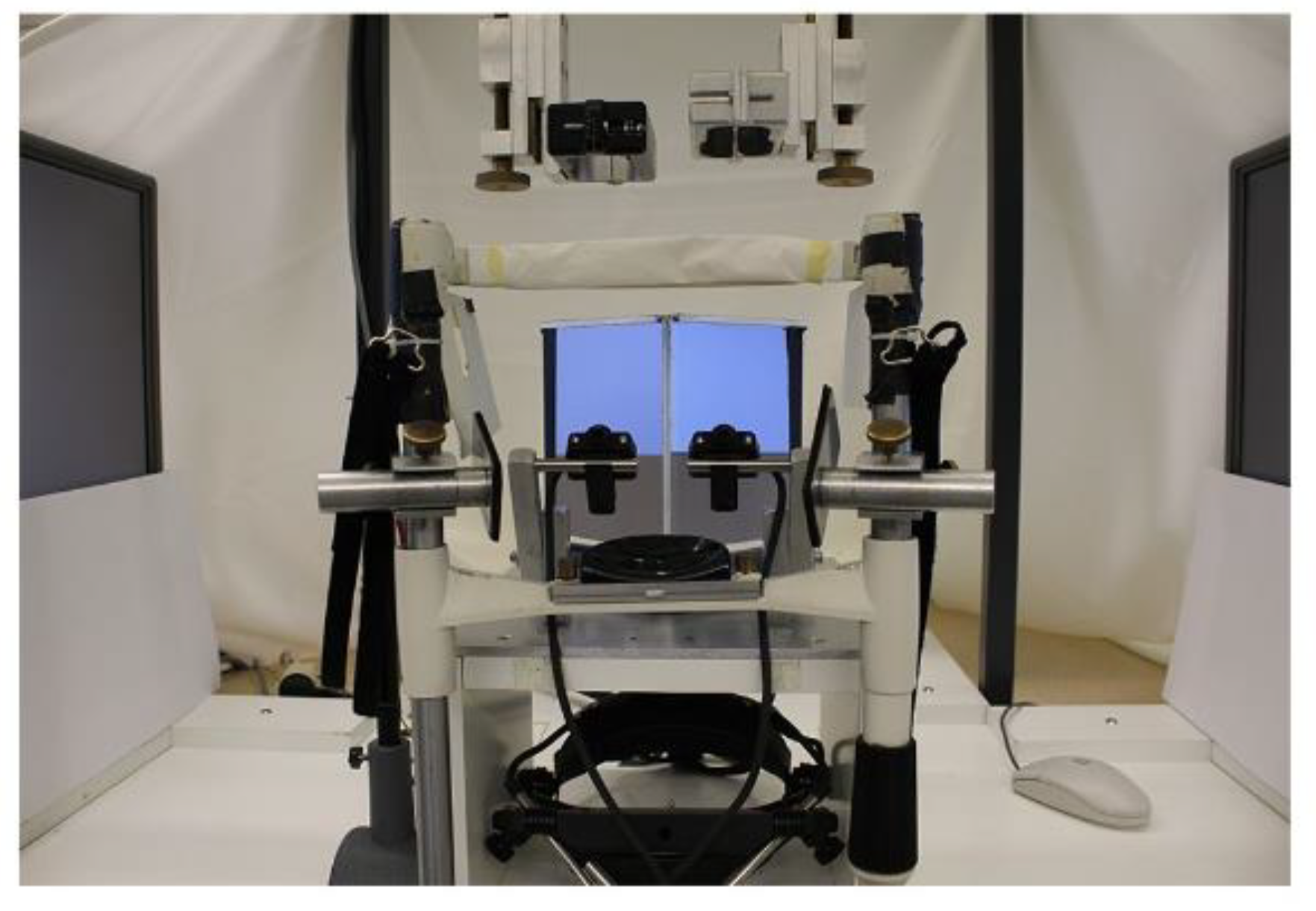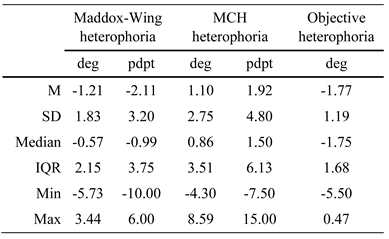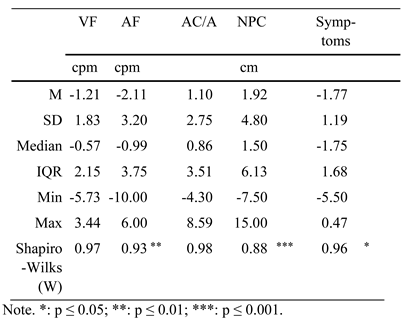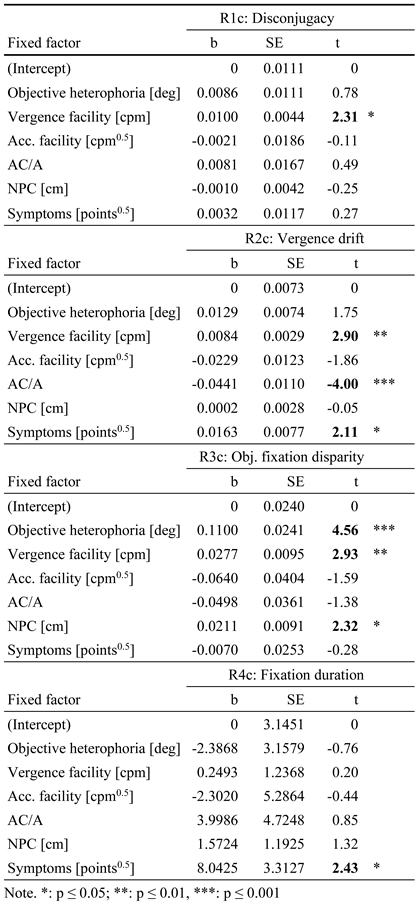Do Standard Optometric Measures Predict Binocular Coordination During Reading?
Abstract
Introduction
Methods
Participants
Reading task and eye movement recordings
Measurements of horizontal heterophoria
- (1)
- The Maddox-Wing test (Trusetal Verband-stoffwerk GmbH, Germany) was used at 30 cm under full dissociation of the visual stimuli (for details see Pointer (2005) and (Evans, 2007)). The right eye only saw an arrow, while the left eye saw a numbered scale. The participant reported at which number the arrow points, which represented the heterophoria in pdpt.
- (2)
- Horizontal heterophoria was also measured at 6 m following the “Guidelines for the Application of the Measuring and Correcting Methodology after H.-J. Haase” (MCH; see www.ivbs.org for details). The test stimuli are presented monocularly (by polarization) under peripheral (or partially central) fusion. Prisms are placed before the participant’s eyes until the dissociated parts of the test stimuli are subjectively perceived as aligned (Schroth, 2012). The value of prisms needed for this alignment represented the heterophoria in pdpt.
- (3)
- Objective horizontal heterophoria was measured at 60 cm with the EyeLink II (Han, Guo, Granger-Donetti, Vicci, & Alvarez, 2010): the participants fixated a central binocular cross for 2.5 s, followed by another cross which was presented to one eye only (for 15 s). Then again, the binocular target was presented for another 2.5 s, followed by a 15 s monocular target to the fellow eye. For each pair of binocular-monocular fixation, objective heterophoria was calculated as difference between vergence angle at the end of monocular fixation minus vergence angle at the end of binocular fixation (given in degree) (Han et al., 2010).
Measures of vergence and binocular accommodative facility
Measurement of AC/A-ratio and near point of convergence (NPC)
Assessment of asthenopic symptoms
Data selection and statistical analysis
- R1. saccade disconjugacy
- R2. vergence drift
- R3. objective fixation disparity
- R4. reading first fixation duration
Results
Binocular coordination during reading
Measures of binocular status
Regression analysis: predicting binocular coordination during reading
Discussion
Ethics and Conflict of Interest
Acknowledgments
References
- Alvarez, T. L., M. Scheiman, E. M. Santos, C. Yaramothu, and J. V. d'Antonio-Bertagnolli. 2020. Convergence Insufficiency Neuro-mechanism in Adult Population Study Randomized Clinical Trial: Clinical Outcome Results. Optometry and Vision Science 97, 12: 1061–1069. [Google Scholar] [CrossRef] [PubMed]
- Bucci, M. P., D. Brémond-Gignac, and Z. Kapoula. 2008. Poor binocular coordination of saccades in dyslexic children. Graefe's archive for clinical and experimental ophthalmology 246, 3: 417–428. [Google Scholar] [CrossRef] [PubMed]
- Bucci, M. P., Z. Kapoula, D. Brémond-Gignac, and S. Wiener-Vacher. 2006. Binocular coordination of saccades in children with vertigo: dependency on the vergence state. Vision Research 46, 21: 3594–3602. [Google Scholar] [CrossRef] [PubMed][Green Version]
- Bucci, M. P., N. Nassibi, C.-L. Gerard, E. Bui-Quoc, and M. Seassau. 2012. Immaturity of the oculomotor saccade and vergence interaction in dyslexic children: evidence from a reading and visual search study. PloS one 7, 3: e33458. [Google Scholar] [CrossRef]
- CITT-ART Investigator Group. 2019. Treatment of Symptomatic Convergence Insufficiency in Children Enrolled in the Convergence Insufficiency Treatment Trial-Attention & Reading Trial: A Randomized Clinical Trial. Optometry and vision science: official publication of the American Academy of Optometry 96, 11: 825–835. [Google Scholar] [CrossRef]
- Collewijn, H. 2001. Interocular timing differences in the horizontal components of human saccades. Vision Research 41, 25-26: 3413–3423. [Google Scholar] [CrossRef]
- Convergence Insufficiency Treatment Trial Study Group. 2008. The convergence insufficiency treatment trial: design, methods, and baseline data. Ophthalmic epidemiology 15, 1: 24–36. [Google Scholar] [CrossRef]
- Daniel, F., A. Morize, D. Brémond-Gignac, and Z. Kapoula. 2016. Benefits from vergence rehabilitation: evidence for improvement of reading saccades and fixations. Frontiers in Integrative Neuroscience 10: 33. [Google Scholar] [CrossRef]
- Dusek, W., B. K. Pierscionek, and J. F. McClelland. 2010. A survey of visual function in an Austrian population of school-age children with reading and writing difficulties. BMC ophthalmology 10, 1: 16. [Google Scholar] [CrossRef]
- Dysli, M., N. Vogel, and M. Abegg. 2014. Reading performance is not affected by a prism induced increase of horizontal and vertical vergence demand. Frontiers in human neuroscience 8: 431. [Google Scholar] [CrossRef]
- Evans, B. J. 2007. Pickwell's Binocular Vision Anomalies, 5th ed. Philadelphia: Butterworth Heinemann Elsevier. [Google Scholar]
- Gantz, L., and A. Caspi. 2020. Synchronization of a removable optical element with an eye tracker: test case for heterophoria measurement. Translational vision science & technology 9, 7: 40–40. [Google Scholar] [CrossRef]
- Han, S. J., Y. Guo, B. Granger-Donetti, V. R. Vicci, and T. L. Alvarez. 2010. Quantification of heterophoria and phoria adaptation using an automated objective system compared to clinical methods. Ophthalmic and Physiological Optics 30, 1: 95–107. [Google Scholar] [CrossRef]
- Heller, D., and R. Radach. 1999. Edited by W. Becker, H. Deubel and T. Mergner. Eye Movements in Reading. In Current Oculomotor Research. Boston, MA: Springer: p. 341. [Google Scholar]
- Hendriks, A. W. 1996. Vergence eye movements during fixations in reading. Acta psychologica 92, 2: 131–151. [Google Scholar] [CrossRef] [PubMed]
- Howard, I. P. 2012. Perceiving in depth, Vol. 1: Basic mechanisms. Vol. 1. [Google Scholar] [CrossRef]
- Howard, I. P., and B. J. Rogers. 2002. Seeing in depth; Depth perception. Toronto, Canada: University of Toronto Press: Vol. 2. [Google Scholar]
- Howarth, P. A., and G. Heron. 2000. Repeated measures of horizontal heterophoria. Optometry and Vision Science 77, 11: 616–619. [Google Scholar] [CrossRef] [PubMed]
- Hussaindeen, J. R., R. George, M. Swaminathan, S. Kapur, K. Ramani, and M. Scheiman. 2015. Binocular vision anomalies and normative data (BAND) in Tamil Nadu–study design and methods. Vision Devel Rehab, 260–270. [Google Scholar] [CrossRef]
- Jainta, S., H. I. Blythe, M. Nikolova, M. O. Jones, and S. P. Liversedge. 2015. A comparative analysis of vertical and horizontal fixation disparity in sentence reading. Vision Res 110, Pt A: 118–127. [Google Scholar] [CrossRef]
- Jainta, S., A. Dehnert, S. P. Heinrich, and W. Jaschinski. 2011. Binocular Coordination during Reading of Blurred and Nonblurred Text. Investigative Ophthalmology & Visual Science 52, 13: 9416–9424. [Google Scholar] [CrossRef]
- Jainta, S., J. Hoormann, W. B. Kloke, and W. Jaschinski. 2010. Binocularity during reading fixations: Properties of the minimum fixation disparity. Vision Res 50, 18: 1775–1785. [Google Scholar] [CrossRef]
- Jainta, S., and W. Jaschinski. 2010. “Trait” and “state” aspects of fixation disparity during reading. Journal of Eye Movement Research 3, 3: 1–13. [Google Scholar] [CrossRef]
- Jainta, S., and W. Jaschinski. 2012. Individual differences in binocular coordination are uncovered by directly comparing monocular and binocular reading conditions. Investigative Ophthalmology & Visual Science 53, 9: 5762–5769. [Google Scholar] [CrossRef]
- Jainta, S., W. Jaschinski, and A. J. Wilkins. 2010. Periodic letter strokes within a word affect fixation disparity during reading. Journal of Vision 10, 13: 11. [Google Scholar] [CrossRef]
- Jainta, S., and J. Joss. 2019. Binocular advantages in reading revisited: attenuating effects of individual horizontal heterophoria. Journal of Eye Movement Research 12, 4. [Google Scholar] [CrossRef]
- Jaschinski, W. 1998. Fixation disparity at different viewing distances and the preferred viewing distance in a laboratory near-vision task. Ophthalmic and Physiological Optics 18, 1: 30–39. [Google Scholar] [CrossRef] [PubMed]
- Jaschinski, W. 2017. Individual Objective and Subjective Fixation Disparity in Near Vision. PloS one 12, 1: 25. [Google Scholar] [CrossRef]
- Jaschinski, W. 2018. Individual objective versus subjective fixation disparity as a function of forced vergence. PloS one 13, 7: e0199958. [Google Scholar] [CrossRef]
- Jaschinski, W., S. Jainta, and W. B. Kloke. 2010. Objective vs subjective measures of fixation disparity for short and long fixation periods. Ophthalmic and Physiological Optics 30, 4: 379–390. [Google Scholar] [CrossRef] [PubMed]
- Kapoula, Z., A. Morize, F. Daniel, F. Jonqua, C. Orssaud, and D. Brémond-Gignac. 2016. Objective Evaluation of Vergence Disorders and a Research-Based Novel Method for Vergence Rehabilitation. Translational vision science & technology 5, 2: 8–8. [Google Scholar] [CrossRef]
- Kim, E. H., V. R. Vicci, B. Granger-Donetti, and T. L. Alvarez. 2011. Short-term adaptations of the dynamic disparity vergence and phoria systems. Experimental Brain Research 212, 2: 267. [Google Scholar] [CrossRef]
- Kirkby, J. A., H. I. Blythe, D. Drieghe, V. Benson, and S. P. Liversedge. 2013. Investigating eye movement acquisition and analysis technologies as a causal factor in differential prevalence of crossed and uncrossed fixation disparity during reading and dot scanning. Behavior Research Methods 45, 3: 664–678. [Google Scholar] [CrossRef][Green Version]
- Kirkby, J. A., L. A. Webster, H. I. Blythe, and S. P. Liversedge. 2008. Binocular coordination during reading and non-reading tasks. Psychological bulletin 134, 5: 742. [Google Scholar] [CrossRef]
- Kliegl, R., A. Nuthmann, and R. Engbert. 2006. Tracking the mind during reading: The influence of past, present, and future words on fixation durations. Journal of experimental psychology: General 135, 1: 12. [Google Scholar] [CrossRef]
- Leigh, R. J., and D. S. Zee. 2006. The neurology of eye movements, 4th ed. Oxford: Oxford University Press: Vol. 70. [Google Scholar]
- Liversedge, S. P., K. Rayner, S. J. White, J. M. Findlay, and E. McSorley. 2006. Binocular coordination of the eyes during reading. Current Biology 16, 17: 1726–1729. [Google Scholar] [CrossRef] [PubMed]
- Liversedge, S. P., S. J. White, J. M. Findlay, and K. Rayner. 2006. Binocular coordination of eye movements during reading. Vision Research 46, 15: 2363–2374. [Google Scholar] [CrossRef] [PubMed]
- Nuthmann, A., and R. Kliegl. 2009. An examination of binocular reading fixations based on sentence corpus data. Journal of Vision 9, 5: 28. [Google Scholar] [CrossRef]
- Palomo-Álvarez, C., and M. C. Puell. 2010. Binocular function in school children with reading difficulties. Graefe's archive for clinical and experimental ophthalmology 248, 6: 885–892. [Google Scholar] [CrossRef]
- Poffa, R., and R. Joos. 2019. The influence of vergence facility on binocular eye movements during reading. Journal of Eye Movement Research 12, 4. [Google Scholar] [CrossRef]
- Pointer, J. S. 2005. An enhancement to the Maddox Wing test for the reliable measurement of horizontal heterophoria. Ophthalmic and Physiological Optics 25, 5: 446–451. [Google Scholar] [CrossRef] [PubMed]
- Rayner, K. 1998. Eye movements in reading and information processing: 20 years of research. Psychological bulletin 124, 3: 372. [Google Scholar] [CrossRef]
- Rouse, M. W., E. J. Borsting, G. Lynn Mitchell, M. Scheiman, S. A. Cotter, J. Cooper, and C. I. T. T. Group. 2004. Validity and reliability of the revised convergence insufficiency symptom survey in adults. Ophthalmic and Physiological Optics 24, 5: 384–390. [Google Scholar] [CrossRef]
- Scheiman, M., C. Chase, E. Borsting, G. L. Mitchell, M. T. Kulp, S. A. Cotter, and C. R. S. Group. 2018. Effect of treatment of symptomatic convergence insufficiency on reading in children: a pilot study. Clinical and Experimental Optometry 101, 4: 585–593. [Google Scholar] [CrossRef]
- Scheiman, M., and B. Wick. 2019. Clinical management of binocular vision: heterophoric, accommodative, and eye movement disorders, 5th ed. Philadelphia: Lippincott Williams & Wilkins. [Google Scholar]
- Scheiman, M., C. Yaramothu, and T. L. Alvarez. 2019. Changes in the disparity vergence main sequence after treatment of symptomatic convergence insufficiency in children. Journal of Eye Movement Research 12, 4. [Google Scholar] [CrossRef]
- Schor, C. M. 2011. Edited by L. A. Levin, S. F. E. Nilsson, J. Ver Hoeve and S. M. Wu. Neural control of eye movements. In Adler's physiology of the eye, 11th ed. London: Saunders Elsevier: pp. 220–242. [Google Scholar]
- Schroth, V. 2012. Binocular Correction: Aligning prisms according to the Haase approach, 1st ed. Netherlands: Zijdar Book. [Google Scholar]
- Schroth, V., R. Joos, E. Alshuth, and W. Jaschinski. 2019. Short-term effects of aligning prisms on the objective and subjective fixation disparity in far distance. Journal of Eye Movement Research 12, 4. [Google Scholar] [CrossRef]
- Schroth, V., R. Joos, and W. Jaschinski. 2015. Effects of prism eyeglasses on objective and subjective fixation disparity. PloS one 10, 10: e0138871. [Google Scholar] [CrossRef]
- Sheedy, J. E., and J. J. Saladin. 1978. Association of symptoms with measures of oculomotor deficiencies. American journal of optometry and physiological optics 55, 10: 670–676. [Google Scholar] [CrossRef]
- Steinman, S. B., B. A. Steinman, and R. P. Garzia. 2000. Foundations of binocular vision: a clinical perspective. McGraw Hill Professional. [Google Scholar]
- Talasan, H., M. Scheiman, X. Li, and T. L. Alvarez. 2016. Disparity vergence responses before versus after repetitive vergence therapy in binocularly normal controls. Journal of Vision 16, 1: 7. [Google Scholar] [CrossRef] [PubMed]
- Vernet, M., and Z. Kapoula. 2009. Binocular motor coordination during saccades and fixations while reading: a magnitude and time analysis. J Vis 9, 7: 2. [Google Scholar] [CrossRef] [PubMed]
- Wajuihian, S. O. 2018. Prevalence of heterophoria and its association with near fusional vergence ranges and refractive errors. African Vision and Eye Health Journal 77, 1: 9. [Google Scholar] [CrossRef]
- Yang, Q., and Z. Kapoula. 2003. Binocular coordination of saccades at far and at near in children and in adults. Journal of Vision 3, 8: 3–3. [Google Scholar] [CrossRef]
- Yekta, A., L. Pickwell, and T. Jenkins. 1989. Binocular vision, age and symptoms. Ophthalmic and Physiological Optics 9, 2: 115–120. [Google Scholar] [CrossRef]


 |
 |
 |
 |
© 2021 by the authors. This article is licensed under a Creative Commons Attribution 4.0 International License.
Share and Cite
Joss, J.; Jainta, S. Do Standard Optometric Measures Predict Binocular Coordination During Reading? J. Eye Mov. Res. 2020, 13, 1-12. https://doi.org/10.16910/jemr.13.6.6
Joss J, Jainta S. Do Standard Optometric Measures Predict Binocular Coordination During Reading? Journal of Eye Movement Research. 2020; 13(6):1-12. https://doi.org/10.16910/jemr.13.6.6
Chicago/Turabian StyleJoss, Joëlle, and Stephanie Jainta. 2020. "Do Standard Optometric Measures Predict Binocular Coordination During Reading?" Journal of Eye Movement Research 13, no. 6: 1-12. https://doi.org/10.16910/jemr.13.6.6
APA StyleJoss, J., & Jainta, S. (2020). Do Standard Optometric Measures Predict Binocular Coordination During Reading? Journal of Eye Movement Research, 13(6), 1-12. https://doi.org/10.16910/jemr.13.6.6



